#finnish history
Explore tagged Tumblr posts
Text
hitler's visit to finland

marshal wilhelm keitel, hitler, mannerheim and president risto ryti (1942)
on june 4th 1942, hitler made a visit to finland under extreme secrecy to celebrate the 75th birthday of the marshall of finland, carl gustav mannerheim.
this was hitlers only stay outside of the 3rd reich that summer, and overall an odd venture. hitler didn't travel much in general, and when he did, it was business related. the real purpose of the visit was to ensure finland stay allied to nazi germany.
the visit took place in imatra, where hitler was greeted at immola airfield by president risto ryti and finnish officials, then accompanied to mannerheims personal train. there a birthday meal and negotiations took place.

hitler dining with finnish prime minister jukka rangell, president risto ryti and mannerheim (1942)
during his visit, in this train car the only known recording of hitler's normal voice was taped.
a sound engineer for the finnish brodcaster yleisradio (yle) thor damen, had been tasked with recording hitler's official speech and birthday message to mannerheim, after which thor continued to record the private conversation between the two without permission.
after 11 minutes, hitlers ss guards noticed and made a cutthroat gesture as a polite suggestion for him to stop recording. they demanded for the tape to be destroyed, but yle was eventually allowed to keep it in a sealed container with the promise of it not being opened again.
it was made available to the public later in 1969, and you can listen to it here:
youtube
many doubted its authenticity after the tapes release due to hitlers voice being 'too soft'. the reason for this was most likely the fact he'd been drinking, something hitler didn't do often.
today, a largely unknown stone plaque commemorates the meeting, 400 metres away from it's original place as it was moved in 1994 to a quieter location due to it being in an industrial area.

the memorial plaque, saivaanhoivintie imatra
the coach in which the meeting took place in is on display in mikkeli and open to the public once a year on mannerheims birthday.

mannerheims saloon car on display, mannerheimintie 1 mikkeli
#history#educational#1940s#1942#austrian painter#mannerheim#3rd reich#ww2#ww2 history#ww2 germany#finnish history#reichblr#reich fandom
114 notes
·
View notes
Text
youtube
A wonderful video of the building and upgrading of Turku Castle through the centuries! Posted by the Turku City Museum.
#finland#history#finnish history#turku#turku castle#turun linna#åbo slott#suomi#åbo#14th century#15th century#13th century#16th century#20th century#video#3d model#Youtube
76 notes
·
View notes
Text
MINNA CANTH // ACTIVIST
“She was a Finnish writer and social activist. Canth began to write while managing her family draper's shop and living as a widow raising seven children. Her work addresses issues of women's rights, particularly in the context of a prevailing culture she considered antithetical to permitting expression and realization of women's aspirations. The Worker's Wife and The Pastor's Family are her best known plays, but the play Anna Liisa is the most adapted to the films and operas. In her time, she became a controversial figure, due to the asynchrony between her ideas and those of her time, and in part due to her strong advocacy for her point of view. Minna Canth was the first major Finnish-language playwright and prose writer after Aleksis Kivi, the national author of Finland, and the first Finnish-language newspaper woman. She was also the first woman to receive her own flag flying day in Finland, starting on 19 March 2007. It is also the day of social equality in Finland.”
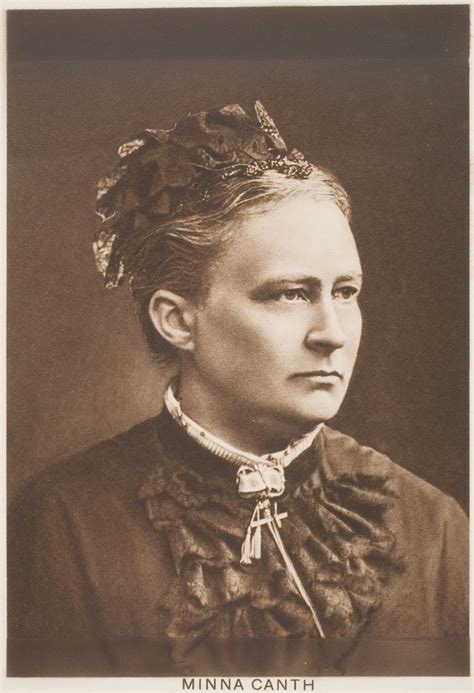

55 notes
·
View notes
Text
shoutout to that one finnish dude with enough methed-up sisu to give god “alzheimer’s requiem” who went on a wild ride through the karelian wilderness for like a month during the continuation war
#aimo koivunen#world war ii#continuation war#winter war#finnish history#i fear no man#but that thing#it scares me#cw: dementia reference#cw: drugs#finland#real world history#reality is stranger than fiction#cw: finland
20 notes
·
View notes
Note
Hey, I noticed that in one of your posts you showed an Iron Age Finnish woman's dress. Would you happen to have a good idea of what Finnish men were wearing in that era? The information on it seems sparse. I do have a relevant book that I'm about to look through, but I'd like to hear your insight too!
Hi! Thanks for the question (and sorry for the slow answer), I do love Finnish Iron Age clothing so it's always my pleasure to write about it. I've been wanting to do a deep dive into this for a long while, so maybe I'll do at some point a post about women's dress too.
Unfortunately no one has good idea of the Finnish Iron Age men's dress (and if you find any book or other source that claims otherwise, do not trust it), since there's much fewer archaeological finds of men's dress than women's dress. The most accepted theory on why the textiles of women's dress survived surprisingly well is because of the bronze ornamentation commonly sewn into especially the fine women's dresses of the era. The bronze protected them from decomposing fully. Presumably men's dresses were not decorated similarly then. There are some finds though and we can piece together at least some kind of vague picture.
I will be discussing the period from Viking Age to Crusade Age in Finland. Viking Age is often defined to cover 800s to mid-1000s and the Finnish Crusade Age started right after the Viking Age and ended in the end of 1200s, where the Finnish Medieval era begins. Crusade Age refers to the period where mostly Swedish (also German) crusaders in the span of couple of centuries conquered lands of the Baltic-Finnic pagans. The crusades of this period targeted pagans all over eastern Baltic Sea, including Baltic-Finnic Karelians, Livonians and Estonians, and Baltic peoples, and the Scandinavia too, where Sámi people were targeted. After that the Finland and Sápmi were colonized by Norse people and stayed that way untill Finland was transferred under Russian rule, but to this day Sápmi still stays under colonial rule, including Finnish colonial rule. The current Finland was very multicultural area, mostly populated by Finno-Ugric peoples, including Sámi people, Karelians and various Finnish peoples.
It's important to understand that even just Finnish peoples where not homogeneous, but had distinct, yet of course strongly related cultures. These were Finns (suomalaiset) (yes most people we now call Finns were not in fact called that) in the coast of southwestern and western Finland, Tavastians (hämäläiset) in central-western lake-Finland and Savonians (savolaiset) in central-eastern lake-Finland. This means we can't mix findings from all over Finland to reconstruct a dress without evidencing that all the elements were actually used in one place. These three tribes had broadly similar base for their clothes, but distinctive jewelry and detailing. The big divide was and has always been between eastern and western Finnish peoples. This is because western Finnish people were in close contact through the sea with Norse people and southern Baltic-Finnic peoples, while eastern Finnish people, Savonians mostly, were influenced a lot by their proximity with Karelians. Another dividing factor was the very different environmental conditions between western and eastern Finland. The Finnish coast especially in west is very flat and fertile land, while the lake area, especially in eastern Finland is very rocky, hilly and quite infertile. The main way it effected clothing differences was that western Finland being more wealthy had more elaborate clothing. Tavastians in both occasions fall quite in between, but they tended to be more in the western cultural camp.
My most important sources are a study by a doctor of cultural anthropology, Jenny Kangasvuo, Savon historia I (Savonian history) digitized and open sourced here and the digitized archeological collection of Finnish Heratage Agency. They are all in Finnish so not very useful for most people unfortunately.
Finnish Men's Dress in Viking and Crusader Ages
The basic garments men wore were broadly similar as women. They wore a shift/shirt, knee or above-knee length dress, cloak, belt, shoes and some kind of headwear. Wool was used most commonly, though the shirt would sometimes be linen too. Even evidence of silk has been found in some western Finland graves. I would assume that would be from a dress of some great man, who traveled to gain riches, possibly with vikings. Embroidery and decoration with metals was a typical feature of the whole Eastern Baltic Sea area. In Finland during this period bronze was the most common decorative metal, but silver was used too. Decorative elements were usually woven with small bronze spirals into all kinds of patterns. Here's examples from the reconstructed Ravattula's dress (Finns) used by women.
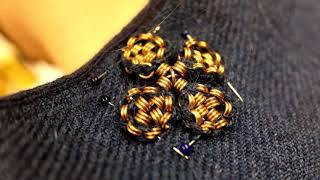
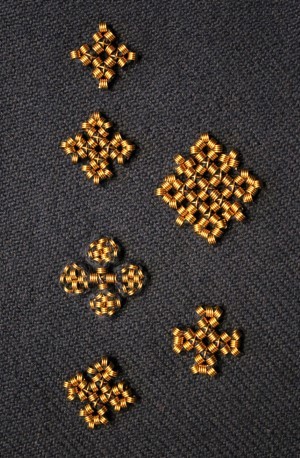
Shirt
The shirt (in Finnish shift of both women and men was called shirt) was basically a long shirt or under dress. We can assume it was similar to those of women's except shorter since the dress men wore was shorter too. They were made from wool or linen, I would assume wool was used in winter and linen in summer, when linen was even available. The neckline had a cut and closed with a bronze brooch. Horseshoe brooch was common. The first one is a quite typical bronze horseshoe brooch with a bit of ornamentation from Salo (Finns). The second one is from Tuukkala, (Savonians), it has exceptional ornate detailing and is uncommonly silver, not bronze. The third picture has two quite uniquely ornamented horseshoe brooches, first from Köyliö (Finns), second from Kurikka (Finns).
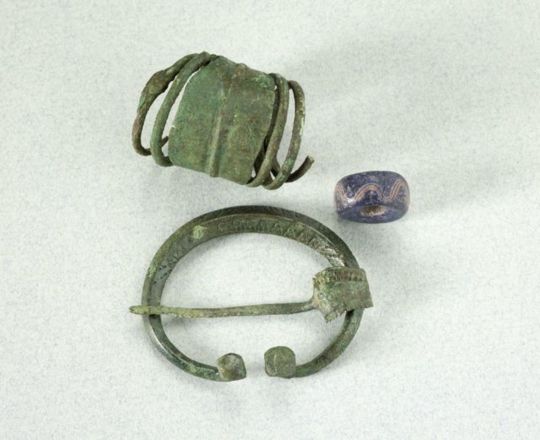


Legwear and footwear
Very little of men's legwear has survived and it's unclear weather men wore pants or separate pant legs, leg wraps or perhaps long socks. Evidence of strings decorated with bronze spirals and tablet woven band has been found in leg area of men's graves. This could mean that they wore either leg wraps, long sock or some sort of pant legs that needed to be secured with string or band under knee. Women used strings and tablet woven tape to secure leg wraps and socks, which I think supports that theory. Sometimes both bronze decorated string and tablet woven band was found in the leg area, which would still be explained by this theory, since it was common to decorate the ends of the bands with bronze decorated strings. Here's an example of sock bands just like that from the earlier mentioned reconstruction of the Ravattula's women's dress. Since men's dress was shorter, I think it would make sense if they still wore some kind of pants or separate pant legs with socks or leg wraps like that.

However, the strings and bands could have also been part of the shoes. Everyone probably wore similar shoes - laced leather shoes with a bit of pointed end. They might have been short or ankle length and the lacing was done with either leather cord or tablet woven band, which would also explain the findings. Socks or feet wraps would have been used in them, and straw or wool could be added as filling for warmth. Here's a pair of traditional Izhorian shoes from Estonia from early 1900s, and a pair of traditional Sámi shoes. The designs were likely roughly similar in Viking and Crusader Ages, though obviously more simple, and it's probable that Finnish shoes very something like that too. Here's a 1893 drawing of what findings of shoe material from Korpiselkä (Savonian or Karelian) might have looked like. Considering the quality of archaeology of that time, copious amounts of salt should be applied. And finally as a fourth picture there's reconstruction shoes from Ravattula's dress.
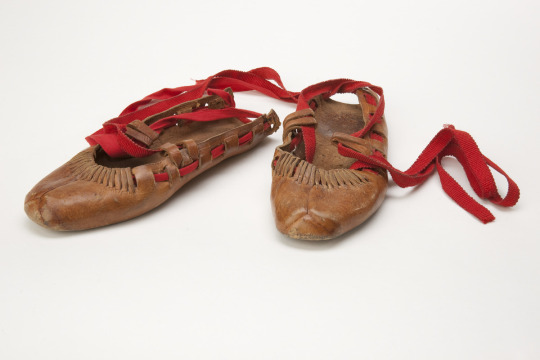
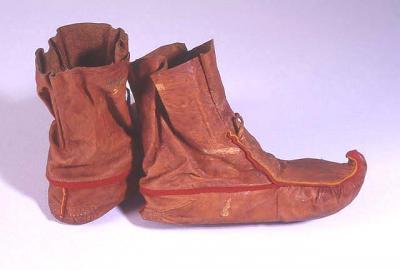
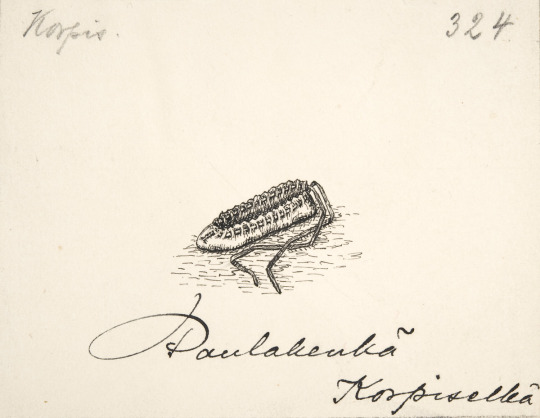
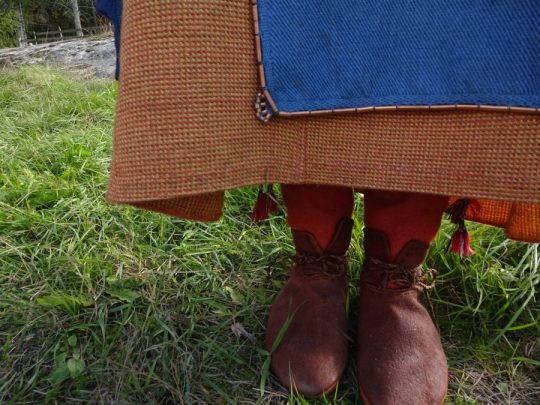
These are not necessarily mutually exclusive theories. The lacing of the shoe could have been laced up the leg and used also to secure either sock or leg wrapping, or they could have been separately secured in ankle and knee respectively.
In some graves twill fabric has been found in the leg area. It could be part of pants or for example leg wrapping, which was often made of twill. One theory about pants is that they were similar as some findings in Sweden, where fairly tight pants made of twill were secured at the hem with buttons similar to cuff studs. These kinds of cuff stud buttons are quite a common find in Finland and some have been found in men's graves close to legs.
Dress
Again there's not much findings of dresses, but a little more perhaps. It was usually from wool. The shape was either a tunic or an open coat. In Karelia there's findings of men's dress suggesting tunics thicker than women's dresses and made from sarka, a type of broadcloth. On the other hand, in Masku (Finns) they found buttons in a row on top of the torso, which suggest a coat closed with buttons. The first picture is a drawing of the grave find. Similary coak closing amounts of buttons have also been found in other places in western Finland. This suggests that Finns and probably Tavastians too wore long coats buttoned to the waist and Savonians wore tunic of Karelian influence. Below there's couple of version of what might this western Finnish men's coat dress could've looked like. The first is an imagined version of the coat based on the Masku grave finds, second is just as imagined version based on Eura (also Finns) grave finds.
Take these "reconstructions" with a strong dose of salt. These are more artistic reconstructions than scientific, since there's not enough material and too much guesswork needs to be done. And because we can see in the Masku grave drawing right here that the other deceased has a large buckle to (probably) close the shirt (to be fair, it could for a cloak too), like was typical, I find it implausible that the coat neckline would be small and round covering the buckle. If you make a decorated big buckle, I assume you want to show it. I would find a v-neckline more probable. It's also easier to make without wasting expensive fabric.


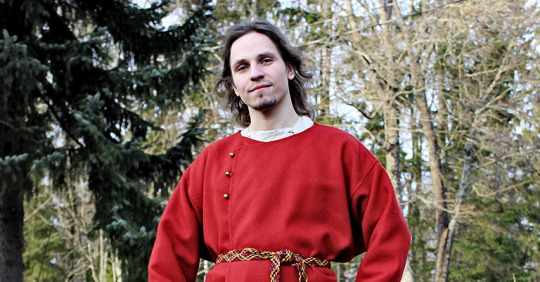
The buttons are interesting. There were what you would imagine - your typical buttons made of bronze like seen in the first artifact from Hattula (Tavastians). But then there was silver jingle bells used as buttons, found for example in both Masku and Eura graves, Eura findings pictured below.

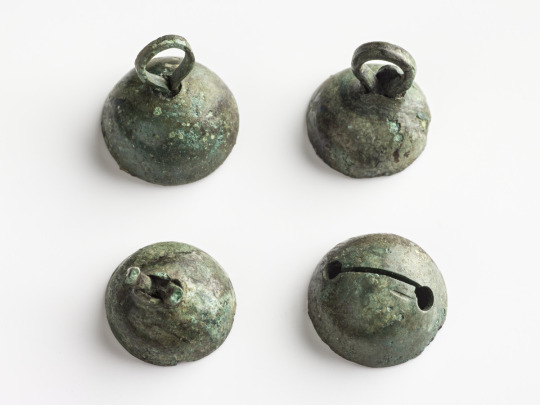
It's possible, even probable I'd say, that the hemlines of men's dresses were finished with tablet weaving patterns, like women's dresses. Also I would assume the pattern of the men's dress (and shirt) was mostly similar to the women's underdress/shirt patterns. So here's couple of different reconstruction patterns for women's dress. Different historians have made different interpretations of the patterns, so it's very much undecided what it really was like.


Belt
This is likely the most ornamental part of men's dress. They could be made out of leather or tablet woven band. And there's another east-west cultural divide here. Karelian belts were made out of leather, were usually 1,5-2,5 cm wide, decorated with iron or bronze studs and had a buckle made out of iron or bronze. These types of belts have been found in Savonia too, for example in Tuukkala grave find, which you can find very cool pictures of in this photo documentation of the dig in pages 173-175. In western Finland a "hela" belt was the common style. I don't think there's a world for hela in English. It's a sort of decorative lamella, small metallic plate (not necessarily square but often so) attached to fabric or leather with studs or sewing. Hela belt came from the Permians of Kama river, who were one of the many Finno-Ugric peoples who used to populate much of European side of Russia. Karelians lived closer to Permians, so you might think Permians would influence eastern Finland more, but my theory is that the costal Finns, who frequently joined viking crews and at least were in close contact with merchants including vikings, who would travel along the eastern route through the eastern European rivers, where they could go all the way to Kama river or at least meet traveling Permians. Here's yet another Finnish source more on the Finno-Ugric people around Kama river.
Anyway, hela belt was made of leather and filled with small decorated lamellas, often in square shape, but various other shapes too, like animal ornamentation. In this period hela belt helas were bronze. First image is a nice full set of hela belt metal pieces found in Pirkanmaa (Finns). Second is an older example, right before Viking Era, from Vaasa, costal settlement, (Finns), depicting a very Permian style. The third one is a lion hela found separately in Pälkäne (Tavastians). They are also found in Tuukkala, showing that both eastern and western cultural influences were present there at the same time.
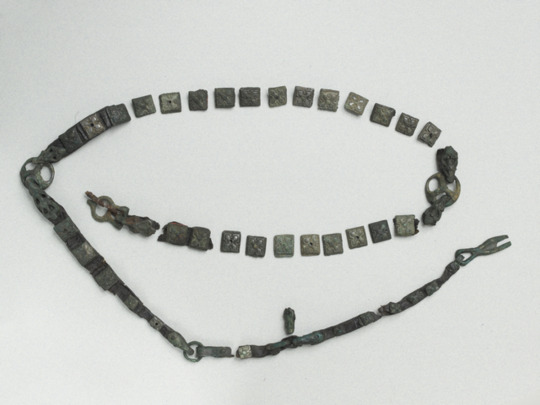
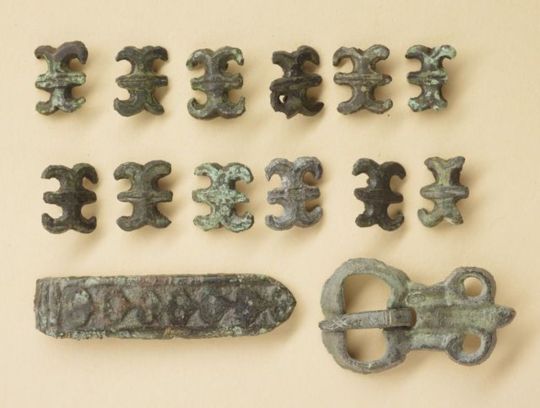

Another western Finnish belt type for men had intricate tassels decorated with bronze spirals hanging on the waist at the end of the belt. They could be made out of leather or tablet woven band. First image depicts a reconstruction of such tassel. Belts in east and west would have strap dividers to hang straps for things like purse, knife and sword. The first picture above has couple of those, but the second picture below has two more of them in more detail in the middle of the picture. These finds are from Lieto (Finns).
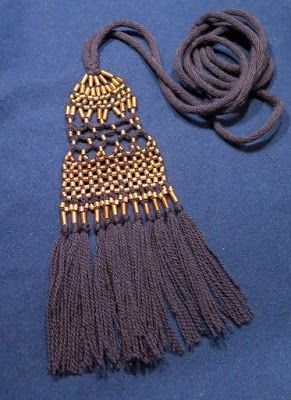
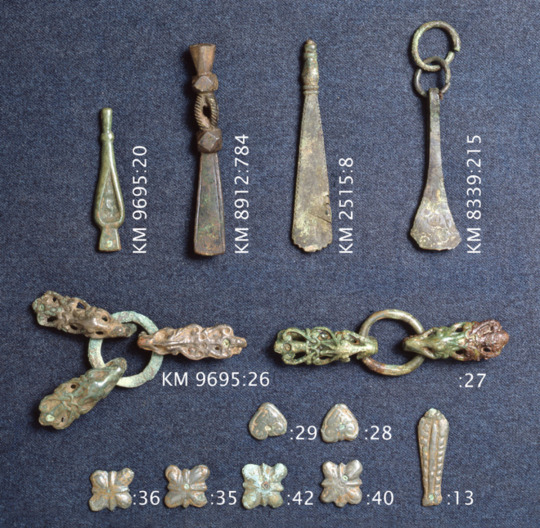
Cloak
Like women's cloak, men's cloak was woolen and either a square or trapezoid. Cloak is yet another east-west divide. In western Finland men's cloaks have embroidery with bronze spirals. They in fact appeared earlier in men's cloaks (in 900s) than in women's cloaks (1100s). They were also a little different in men's cloaks. The spirals and the patterns themselves were bigger and the fastening thread itself was also used for the pattern creation, unlike in women's dresses, where the thread was mostly covered. In eastern Finland there has been no finds of bronze decorations in men's cloaks, mostly only cloak brooches have been left of them. Unsurprisinly same applies to Karelia. This also means there's very little fabric left too. There's one exception. In Tuukkala (Savonians) they found a piece of fabric probably from men's cloak, though it could be from a men's dress too. It was striped, with possibly white or brown base and wide stripes of red, blue and yellow. So perhaps eastern Finnish cloak was not non-decorated, but the decoration was in the fabric pattern. Unfortunately it's hard to know how common fabric like that was, when so little of it is left.
Accessories
It's safe to assume men too wore some type of headwear, but none of those has survived. It probably means it was entirely made out of fabric whatever it was. Some type of hat or cap was certainly used in cold weather at the very least. Tablet woven headband was also possible option for not too cold weather.
In Tuukkala there was couple of interesting jewelry finds too. Two graves had a necklace type mostly found in Karelia. It was birchbark tape covered with nettle fabric and had square helas sewn into it. There were also more typical Finnish necklaces made of beads and bronze spirals.
Razors have also been found with men in their burials, so we can assume shaven faces or at least trimmed beards and moustaces were fashionable.
#dress history#historical fashion#historical clothing#fashion history#history#iron age dress#finnish iron age dress#finnish history#archaeology#answers#anon
236 notes
·
View notes
Text
The Vottovaara incident is deliciously frustrating!
Mount Vottovaara is a hill in the Republic of Karelia, modern-day Russia. The Winter War was fought between Finland and the Soviet Union between November 1939 and March 1940.
Here’s what we know: Vottovaara was/is a sacred site to the people living in the area (the Sámi).
Here’s what we’ve heard (from Finnish soldiers): in January 1940, a group of Soviet soldiers ascended Mount Vottovaara. In the following nights, the Finnish troops situated nearby heard gunshots et cetera, yet no Finnish soldiers were engagin with the Soviets. When Mount Vottovaara became silent, the Finnish soldiers went to see what had happened. All the Soviet soldiers had been basically slaughtered—torn to pieces, brutally disemboweled, et cetera—, okay, some had taken their own lives. No remains of wild beasts were anywhere to be found, nor where there any remains of any other armed people—just the Soviets.
Here’s what we’ve also heard (from whom? I don’t know): that the Soviets were warned (by the locals) not to ascend Vottovaara.
Here’s what we absolutely do not know: What killed them? Was it a Stállo? Or werewolves? Or something more mundane—like a massive pack of wolves?
I need answers.
24 notes
·
View notes
Text

Girl from the female companies of the Finnish Red Guard, Finnish Civil War, 1918
14 notes
·
View notes
Text

Demonstration in Helsinki against the Soviet-led invasion of Czechoslovakia in August 1968. X
#20th century#finland#finnish history#soviet union#russian invasion#czech history#czechoslovakia#black and white#protest#demonstration#anti communism#1960s#street scene#1968#helsinki#august
22 notes
·
View notes
Text
The 6th of December 2017 was the Finnish Independence Centennial. An entire year of the most psychotic jingoism coinciding with me having my military callup permanently broke my brain which eventually lead to my mental breakdown a few years later and I'm still experiencing the after effects.
It was actually insane. They had this logo that said "Suomi Finland 100" and they put on literally everything you could imagine. Books, stamps, coins, medals, chocolates, shirts, glassware. There were centennial dishrags and toilet plungers for sale (not joking!)
I found it so perverse how everyone was caught in this mania of patriotism and national pride talking about how Our Brave Veterans gave us our independence and shit. There was a historian who published a study about Finnish SS volunteers and he was viciously attacked and defamed in the press and public discourse for weeks. And no one ever even mentioned the Civil War that started in January 1918, less than two months after the declaration of independence. That war was awful. Many people died in combat and in the end thousands of Red POWs and surrenderers were murdered in extermination camps without trial. Thousands of children were orphaned and the Finnish national psyche was damaged beyond repair. People still can't talk about the war openly over a hundred years later.
The "Spirit of the Winter War" is also ahistorical nonsense. That was achieved through several decades of an oppressive fascist police state and widespread internment of communists, leftists and pacifists after the start of the war. May I also remind you that we lost that war. We lost WWII twice and people still somehow think that was some huge glorious victory. It's very stupid and cringe!
13 notes
·
View notes
Text

Molotov Cocktails, a perfect drink to wash down those Russian troops with!😂
🇫🇮🔥🇺🇦
#history#molotov cocktail#finland#soviet union#russia#military history#vyacheslav molotov#dark humor#russo finnish war#ww2#propaganda#ukraine war#finnish history#funny history#spanish civil war#scandinavia#the winter war#russian history#military#ussr#world war 2#resistance#nickys facts
85 notes
·
View notes
Text
"The kingdom of the young Lion of the North was extensive. It was a land of light and darkness, a sparsely populated wilderness whose ragged, rocky shores were joined by the sea. In the eastern part of the kingdom spread swamps and forests, in the middle of which small villages and fields peeked out. Sneaky spies his in the wilds. The ruler's power only extended to gloomy castles and small coastal towns. There were few roads and they were hardly more than horse tracks. In autumn and winter, the land was covered in darkness, which was illuminated by the moon, stars, and northern lights.
At the beginning of the 17th century, Finland was a chaotic corner of the earth, ravaged by the civil war and famine. In the storms of the turn of the century, it had been on the verge of being completely torn away from the kingdom. In the 1590s, Finland was in the hands of Sigismund's fiercest supporter, Baron Klaus Fleming. Fleming had suspected Duke Charles' intentions and kept the army prepared. At the same time, he had isolated Finland from the motherland. The hard-working Fleming made sure that the Finnish nobility was loyal to him and the king. Fleming's administration and especially the accommodation of soldiers in the castle camp with the peasants caused the peasants, who trusted the Duke's support, to rise up in rebellion. Fleming's forces crushed the rebels in a short but bloody cudgel war in 1596-1597."
Pohjolan Leijona Kustaa II Adolf ja Suomi 1611-1632 by Mirkka Lappalainen
#history#finland#finnish history#sweden#swedish history#klaus fleming#17th century#1600s#charles ix#sigismund iii vasa#cudgel war#the cudgel war#nuijasota#klubbekriget#Clas Eriksson Fleming#suomi#sverige
4 notes
·
View notes
Text
My friend who is a Finn IRL sent me clips of a Finnish historical drama from the early 00s called Hovimäki and I was completely unprepared for this man's cravat.
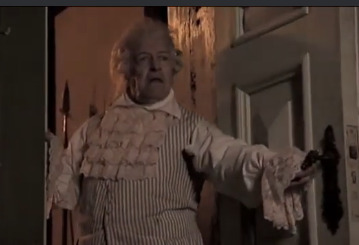

Bonus round: Spot The Swede

#my art#hovimäki#Finnish historical drama#Finnish history#somebody please explain that cravat#it looks like it was made from a topsail#he's about to get blown away by a gust of wind#either SHUT THE DOOR or GO INSIDE bro you are heating the outside
74 notes
·
View notes
Text

"Isontalon Antti ja Rannanjärvi" by Anna Tuomisalo
5 notes
·
View notes
Text
MARY PAISCHEFF // BALLERINA
“She was a Finnish ballet dancer, notable for being the first contracted dancer of the ballet section of the Opera of Finland (later to become the Finnish National Ballet), as well as the company's first principal dancer. She danced the lead role in the first fully Finnish ballet production, as Odette/Odile in Swan Lake, opposite George Gé, which premiered on 17 January 1922.”


(right image is Paischeff and George Gé)
5 notes
·
View notes
Text

Exciting news: Seeker of the Lost Song isn’t called that anymore! I've been mulling over new title ideas for a long time. I wanted one that I felt better represents the story and its particular fantasy novel vibes. And, to be honest, I wanted a shorter one too. I don’t mind long titles but since it’s my own book and a title I’ll probably have to say for years, I fancied something a little more manageable. I also wanted one that would work well with the book’s sequel, and I didn’t even know I was writing a sequel when I chose the original title.
Okay, enough waffling. The novel formerly known as Seeker of the Lost Song is now called Twist the Branch.
It’s fun to say. It’s active. It fits the vibe so much better. It pairs so nicely with its sequel title (Corrode the Song). And I think they both sound pretty metal, which is always something I like in a fantasy novel title. I actually feel such a deep aversion to titling projects, so having one I actually like is nothing short of miraculous. 🤘🏼
Let me reacquaint you with the story:
“History begins where magic ends”
Elis Kalevi knows that standing out is dangerous in the Leitir Empire. The Vetsi people survive by reporting their neighbours’ unconventional behaviour to the ruling Leitir. Fear keeps Vetsi from asking why their stories and language are suppressed, and why their collective history only begins five hundred years earlier with the mysterious Division. Questioning the edicts of Empire violates Memorylaw and is punished by something known only as “rehabilitation.”
Elis struggles to stay on the right side of scrutiny. But when her brother loses control of his forbidden nature magic and they’re both marked for rehabilitation, they escape towards an awakening magic in the east—and the unfamiliar memories of ancient spell-song Elis starts receiving. Travelling through the paranoid Empire with the only two people she trusts and two enigmatic strangers, Elis must uncover her people’s buried history before her mind is overtaken by someone else’s memories. Or before their deception catches up to them.
Twist the Branch is a character-driven adult fantasy novel inspired by medieval Sweden’s rule of Finland and pre-colonial Filipino culture, exploring the mutability of history, the power of the collective, and small actions that fracture oppressive systems. Ideal for fans of Robin Hobb characters, Kazuo Ishiguro reflection, and Skyrim atmosphere.
Photo © Samantha Garner, 2025.
#amwriting#fantasy novel#canadian author#finnish history#filipino history#twist the branch#samantha garner
2 notes
·
View notes
Text

Perfect Red
Digital painting
The Finnish communist who unknowingly brought a spirit from his homeland over the Atlantic. Fox spirit who every now and then forgets there's any difference between themselves and the man who no-one remembers. The horrors of White Finland, horrors that were buried out of convenience and shame, horrors that no-one will admit to, horrors that aren't even horrors in the history books written by the winners. The horrors that made a person dissappear and built another one in his place
Sketch! And the inspiration: theatrical release poster for "Perfect Blue" (パーフェクトブルー) 1998 animated film directed by Satoshi Kon, based on a novel by Yoshikazu Takeuchi


#the jade fox clan#raptorwithink art#anthro art#anthropomorphic#historical oc#comic artist#anthro artist#Finnish history#digital painting#digital art#original character#oc art
1 note
·
View note